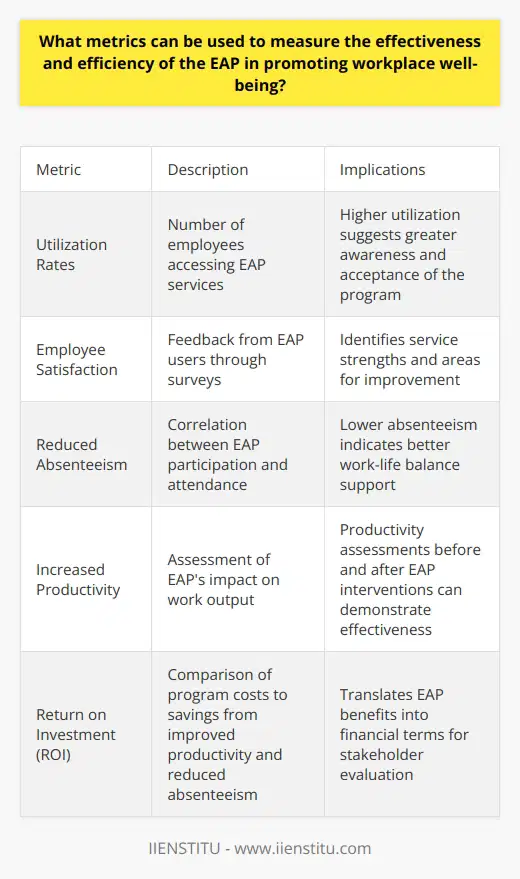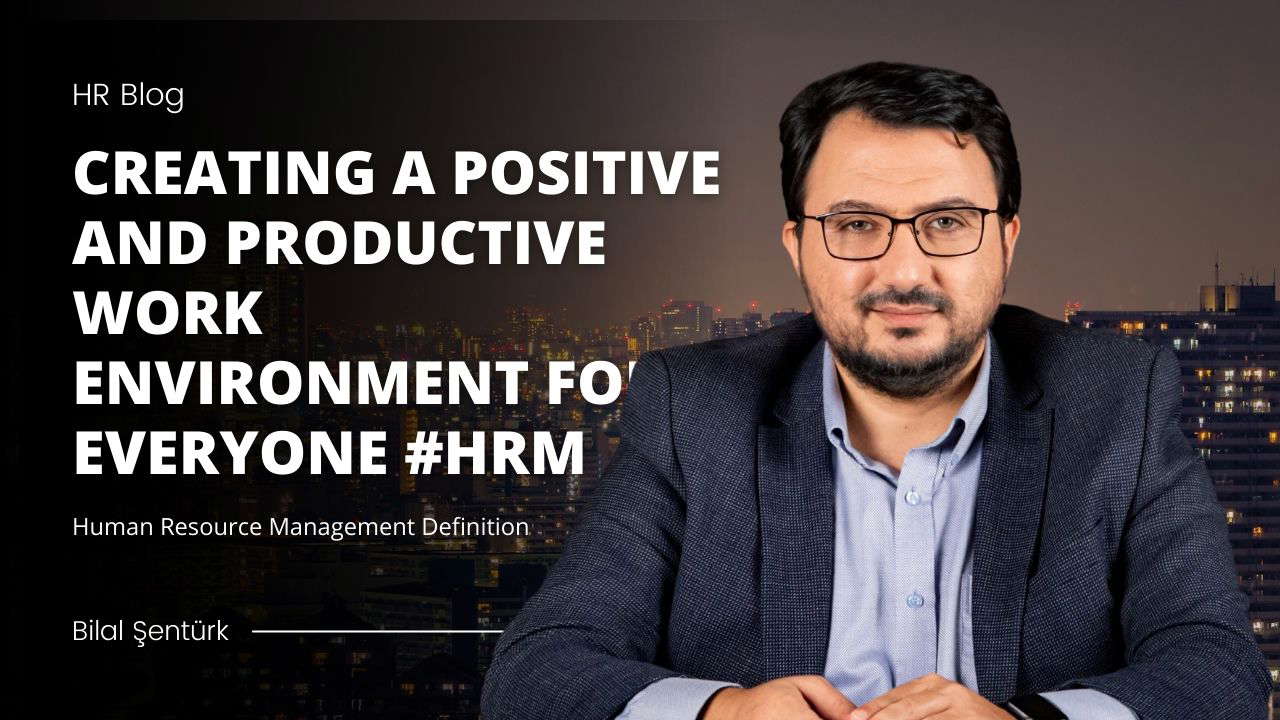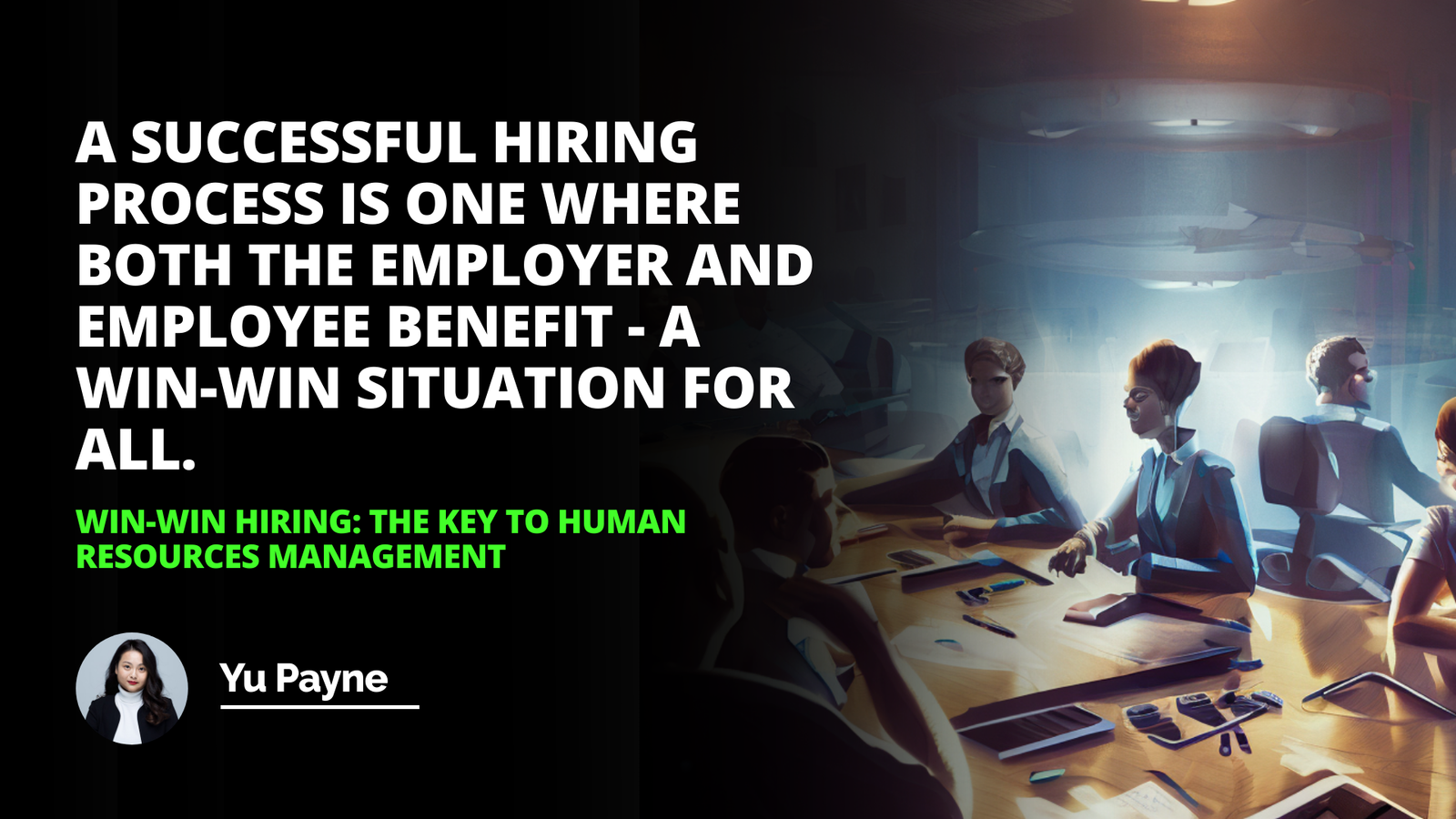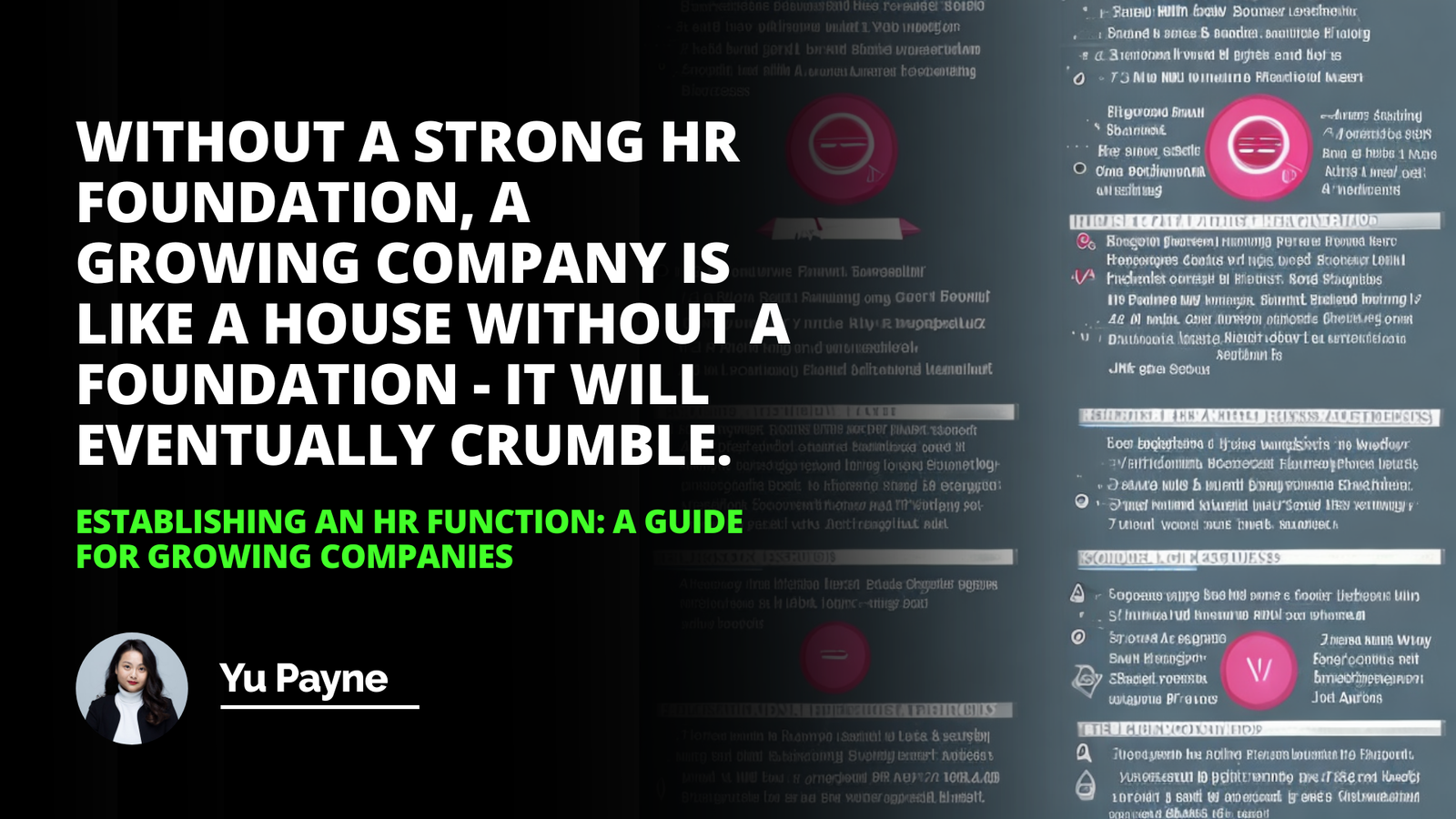
Human Resources (HR) departments tirelessly work to create an environment where employees can thrive professionally and personally. However, as workplaces become more dynamic, so too must the approach HR takes to employee well-being. One of the most crucial aspects of this is the provision of comprehensive support systems—measures designed not only to alleviate immediate distress but also to foster long-term resilience and well-being among staff. As a native English copywriter with a focus on Human Resources, I offer a detailed exploration of HR Employee Assistance, delving into its objectives, elements, and impact on workplace culture.
Introduction to HR Employee Assistance
Employee Assistance within HR is a multidimensional resource that seeks to address and mitigate various employee concerns. This type of assistance ranges from personal and work-related issues to psychological support. The goal is to provide discreet, professional aid that enables employees to overcome challenges that may affect their job performance, health, and well-being. By extension, HR Employee Assistance serves as a proactive catalyst for maintaining a healthy, engaged, and productive workforce.
The importance and role of HR Employee Assistance cannot be overstated. In many cases, the support offered becomes a pivotal point in an employee's career—helping them navigate personal crises or work-related challenges. Additionally, by fostering a supportive and understanding environment, businesses can significantly reduce turnover rates, mitigate absenteeism, and enhance overall productivity.
As for the audience's relevance, professionals engaged in HR, management, and leadership roles will find this exploration particularly beneficial. It offers comprehensive insights into the tools and strategies that enable a robust Employee Assistance framework. This includes HR professionals looking to broaden their understanding, seeking a hr certificate course, or managers aspiring to improve team dynamics with online certification courses in workplace support and assistance.
Understanding the Goals of HR Employee Assistance
The prime objectives of HR Employee Assistance revolve around supporting employees in achieving and maintaining optimal mental, emotional, and occupational health. These objectives address direct aid in crisis management, as well as the provision of resources for long-term problem-solving and personal development. They are designed to help employees feel valued and understood, which is crucial in maintaining a motivated workforce.
Further, HR Employee Assistance supports employees by offering counseling services, conflict resolution, stress management workshops, substance abuse help, and financial or legal consultation. This holistic support system is tailored to address the multifaceted nature of personal and professional challenges that employees might face.
A compelling case study that depicts the impact of successful HR Employee Assistance is drawn from a multinational corporation that witnessed a dramatic downturn in employee turnover and absenteeism statistics following the implementation of a robust assistance program. This success story exemplifies the transformative effect that well-structured support systems can have on an organization's workforce, both in individual well-being and collective productivity.
Highlighting the Necessity of Emotional Support
In the workplace, the importance of emotional support is readily apparent when considering employee engagement and satisfaction. Emotional support through HR Employee Assistance provides a sense of security to employees, reassuring them that the organization values their well-being and personal growth.
HR Employee Assistance programs are engineered to ensure that employees have access to emotional support when they need it. This may include counseling services, peer support networks, or even stress-relieving activities. Emotional support not only helps employees navigate personal difficulties but also fosters a compassionate workplace culture.
Key Elements of Efficient HR Employee Assistance
An effective HR Employee Assistance program is underpinned by several essential components. These components include accessibility, comprehensiveness, professional counseling, and follow-up support. Together, these elements ensure that employees benefit from a service that is both readily available in times of need and sufficiently broad to address a wide range of issues.
The significance of these components lies in their ability to cover the full spectrum of an employee's potential needs. For instance, accessibility means that support is available around the clock, while comprehensiveness ensures that the range of services offered is wide enough to cater to various individual challenges.
Confidentiality and Trust in HR Assistance
A bedrock of effective HR Employee Assistance programs is the assurance of confidentiality. Providing a support system where employees can openly discuss their issues without fear of judgment or reprisal is crucial. This confidentiality fosters trust between the employee and the HR department, a trust that is essential for the program's success.
The role of trust in facilitating effective assistance is also significant. When employees believe that their concerns are genuinely being addressed in a confidential manner, they are more likely to seek and accept help. Sharing examples based on real-career scenarios on how confidentiality and trust have been maintained can help HR professionals understand the delicate balance required in these interactions.
HR Employee Assistance Programs
To comprehend the Employee Assistance Programs (EAPs) is to understand a specialized HR intervention aimed at assisting employees with personal or work-related problems that might hamper their job performance, mental and physical health, or emotional well-being. EAPs are structured to provide confidential, third-party, expert counseling and support services.
Discussing the components and effectiveness of EAPs reveals they typically offer a range of services such as short-term counseling, referrals for additional services, crisis intervention, and even wellness programs. The strategic implementation of comprehensive EAPs is proven to improve employee satisfaction and productivity.
An example of successful EAPs can be found in corporations that have witnessed a decrease in workplace incidents, improved employee morale, and a better work-life balance as a result of their EAP offerings. Such outcomes spotlight the tangible benefits of incorporating well-structured Employee Assistance Programs.
Role of Technology in HR Employee Assistance
Technology plays an increasingly pivotal role in enhancing the effectiveness and reach of HR Employee Assistance programs. Digital platforms can facilitate the confidential and convenient access to support services, allowing employees to seek assistance discreetly and efficiently.
To illustrate, the beneficial impact of technology includes the use of apps or online platforms that provide immediate counseling services or the implementation of AI-driven tools that can preemptively signal the need for employee support based on behavioral data. Such innovative uses of technology in HR Employee Assistance exemplify how digital advancements can greatly augment traditional support mechanisms.
Building an Effective HR Employee Assistance Strategy
Formulating an effective HR Employee Assistance strategy is a comprehensive process that begins with recognizing the unique needs of the workforce, setting clear objectives, and aligning assistance programs with broader organizational goals. Each company's strategy will be unique, yet all should be rooted in a thorough understanding of the company's culture and the diverse needs of its employees.
In discussing the strategy-making process, it is essential to cover aspects such as the initial needs assessment, securing executive sponsorship, selecting appropriate service providers or EAPs, and determining the best channels for promoting these resources to the workforce. Furthermore, continuous evaluation and refinement of the strategy are necessary to ensure its long-term effectiveness.
A solid example of a leading company with an exceptional HR Employee Assistance strategy would be an organization that has integrated mental health support into every aspect of its HR policy, achieving remarkable improvements in workplace wellness and employee retention.
The Future of HR Employee Assistance
Predicting the future direction of HR Employee Assistance involves anticipating ongoing innovations in wellness technologies, the growing importance of mental health at work, and the integration of global support systems to reflect the international nature of many modern businesses. The future will likely see a more personalized approach to employee assistance, making use of big data analytics and refined program offerings.
Emerging trends in HR Employee Assistance suggest a growing recognition of the need for a more nuanced understanding of work-life balance, diversity, and inclusion within the fabric of support programs. These trends point toward a holistic approach that accounts for the myriad factors influencing employee well-being.
The projection of advancements in HR Employee Assistance underscores an ongoing commitment to evolve alongside the workforce it is intended to support. As such, new methods, tools, and approaches will invariably re-shape the landscape of employee support for years to come.
Conclusion
This comprehensive guide to HR Employee Assistance has outlined the breadth and depth of workplace support systems, demonstrating their indispensability in cultivating a healthy and productive organizational environment. For HR professionals, adopting effective Employee Assistance strategies is an investment in their company's most valuable asset: its people.
Encouraging the implementation of these support systems not only fosters a positive work culture but also aligns with ethical business practices and the pursuit of sustainable organizational success. In looking forward, HR Employee Assistance is poised to play an even greater role in how companies approach employee well-being, with promising advancements on the horizon that can only enhance its positive impact.
Frequently Asked Questions
What are the key components of an effective Employee Assistance Program (EAP) in an HR setting?
Defining Employee Assistance Programs
Employee Assistance Programs (EAPs) are workplace resources. They offer confidential support. Their use is for personal and professional problems. These problems can affect work performance. An effective EAP contains several key components.
Core Components of an Effective EAP
Confidentiality
A cornerstone of EAPs is confidentiality. Employees must trust it. Without it, employees may not seek help. Every EAP should ensure privacy for users.
Accessibility
An EAP should be easy to access. Options include phone, in-person, and online support. Services should be available 24/7, ensuring help at any time.
Professional Counseling
Counselors must be qualified. They provide support for a range of issues. These include stress, addiction, and mental health. The quality of counseling can define an EAP's success.
Wide Range of Services
Services should cover diverse needs. They include crisis intervention, legal assistance, and financial counseling. A robust service range can address varying employee challenges.
Management Training
Managers need training to recognize employee distress signals. They should know how to refer employees to the EAP effectively.
Promotion and Awareness
Employees must know about the EAP. Regular promotion ensures visibility. Awareness campaigns can highlight EAP benefits and how to access services.
Integration with Workplace Wellness
EAPs should integrate with other wellness initiatives. This leads to a comprehensive approach. An integrated plan supports the overall wellbeing of employees.
Evaluation and Improvement
Continuous evaluation is vital. It ensures the EAP meets employee needs. Feedback allows for ongoing improvement of services.
Conclusion
Effective EAPs hinge on several factors. Confidentiality and accessibility are essential. So is the quality of counseling. A range of services ensures broader support. Management training, active promotion, and integration with workplace initiatives are important. Regular evaluation allows for refinements. Altogether, these components build a robust EAP in an HR setting.
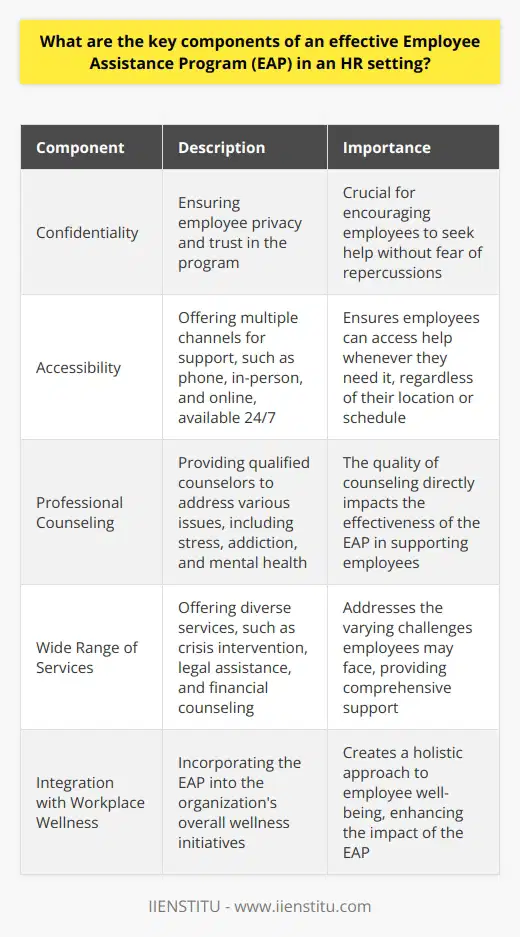
How can HR departments ensure that confidentiality is maintained in the process of providing employee assistance?
Understanding the Imperative of Confidentiality
Confidentiality ranks as a cornerstone in the Human Resources (HR) realm. Employees often entrust sensitive information to HR. They expect utmost discretion. HR departments thus face a critical duty. They must safeguard this data diligently. Failing this, trust deteriorates. Furthermore, legal repercussions may ensue.
Establishing a Robust Confidentiality Policy
Craft a clear policy. This step is fundamental. The policy should delineate the handling of sensitive information. It must cover all potential scenarios. Details are crucial here. Employees must understand what to expect concerning privacy.
Training is key. Regular training sessions can strengthen awareness. HR personnel must know the dos and don'ts. Refreshers are beneficial as they reinforce protocol.
Communicate the policy. Transparency builds trust. Ensure all employees are familiar with the privacy guidelines. Such familiarity reassures them about the handling of their information.
Practical Steps for Safeguarding Privacy
Secure the data. Physical files require locked storage. Digital data demands encryption and secure networks. Limit access to sensitive information. Only relevant personnel should have entry.
Monitor access. Implement tracking systems to audit who views confidential data. This measure discourages unauthorized access. It also creates a trail for accountability.
Manage third-party interactions. Often, external parties come into play. Ensure they adhere to confidentiality agreements. These must be strict and enforceable.
Provide abstracted reports. When reporting on sensitive matters, avoid individual identification. Use aggregated data whenever possible. This practice maintains privacy while presenting necessary information.
Addressing Employee Assistance Specifically
Ensure anonymity in assistance programs. Employee Assistance Programs (EAPs) often deal with personal issues. Anonymity is therefore a must. Offer services in a way that shields identity.
Create a separate entity for assistance. Consider outsourcing EAPs to maintain distance from internal HR processes. This separation can enhance confidentiality perceptions.
Responsiveness to Breaches
Have a response plan. In case of breaches, act fast. Address the breach. Implement corrective measures. Communicate appropriately with affected individuals. Transparency in response upholds integrity.
Implement disciplinary measures. Those who break confidentiality rules should face consequences. Clear repercussions signal the organization's commitment to privacy.
Continuous Review and Improvement
Assess the program periodically. Evaluate the effectiveness of current practices. Gather feedback from employees. Make adjustments where needed.
Stay updated with legal requirements. Laws and regulations evolve. The organization must evolve alongside them to ensure continued compliance.
Each sentence stands as an essential guideline. They form a comprehensive response to safeguarding employee assistance confidentiality. HR departments, by adhering to these principles, establish a culture of respect and privacy. This culture, in turn, empowers employees to seek help without fear of exposure—a critical factor in the overall well-being and productivity of any workforce.

What metrics can be used to measure the effectiveness and efficiency of the EAP in promoting workplace well-being?
Understanding EAP Effectiveness
Employee Assistance Programs (EAPs) serve critical functions. They help individuals manage personal and work-related problems. These issues could impair job performance. Ultimately, EAPs aim to enhance overall workplace well-being.
Key Metrics for EAP Success
To gauge EAP success, consider various metrics. These metrics reflect program use and impact.
Utilization Rates reveal employee engagement with EAP services. They count the number of employees accessing the program. Higher utilization often implies greater awareness and acceptance.
Employee Satisfaction measures feedback from EAP users. Satisfaction surveys can provide insights. They can help identify service strengths and areas for improvement.
Reduced Absenteeism links EAP services to attendance. Does EAP participation correlate with fewer absences? Lower absenteeism can indicate better work-life balance support.
Increased Productivity assesses the EAP's impact on work output. It can be hard to measure. Still, productivity assessments before and after EAP interventions matter.
Lowered Workplace Incidents can show the EAP's influence on safety. Fewer incidents mean a healthier workplace environment. This reduction can also underscore better personal coping strategies.
Healthcare Usage Trends can reflect EAP effectiveness. Look for changes in healthcare claims related to mental health. The EAP might be helping employees manage stress better.
EAP Case Outcomes trace specific interventions. What were the results? Case outcomes detail the resolution of individual employee cases.
Return on Investment (ROI) translates EAP benefits into financial terms. ROI calculations can compare program costs to savings from improved productivity and reduced absenteeism.
Analyzing Data for Informed Decisions
Employ these metrics thoughtfully. They can guide EAP strategy and implementation. Remember, human resources involve individual experiences. Numbers tell part of the story. They must pair with qualitative feedback. Surveys, focus groups, and interviews add depth. They provide context to the numerical data.
Continuous evaluation is essential. Collect data regularly. Use it to refine the EAP offerings. Understand that workplace well-being is a dynamic concept. It evolves with societal changes. An effective EAP adapts to these changes.
EAP providers should share findings transparently. Clear communication with all stakeholders is key. It ensures that the program aligns with the employees' needs.
Stakeholder involvement also has its place. Encourage employees to participate in evaluations. This engagement can foster a sense of ownership. It can also lead to more tailored program enhancements.
In conclusion, targeted metrics offer a robust framework. They help evaluate EAP effectiveness and efficiency. Pair quantitative analysis with qualitative insights for balance. An agile, responsive EAP can thus promote workplace well-being. It can also adapt to emerging challenges.
Such an approach ensures that EAPs continue to serve as vital support mechanisms. They can effectively address the complexities of work and personal life. This, in turn, nurtures a healthier, more productive workforce.
